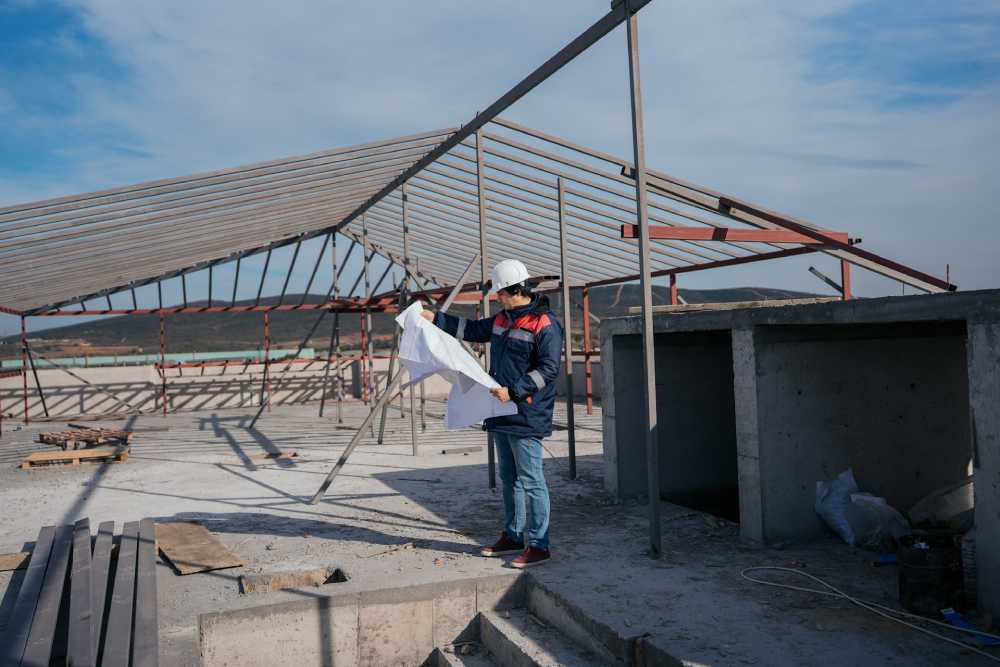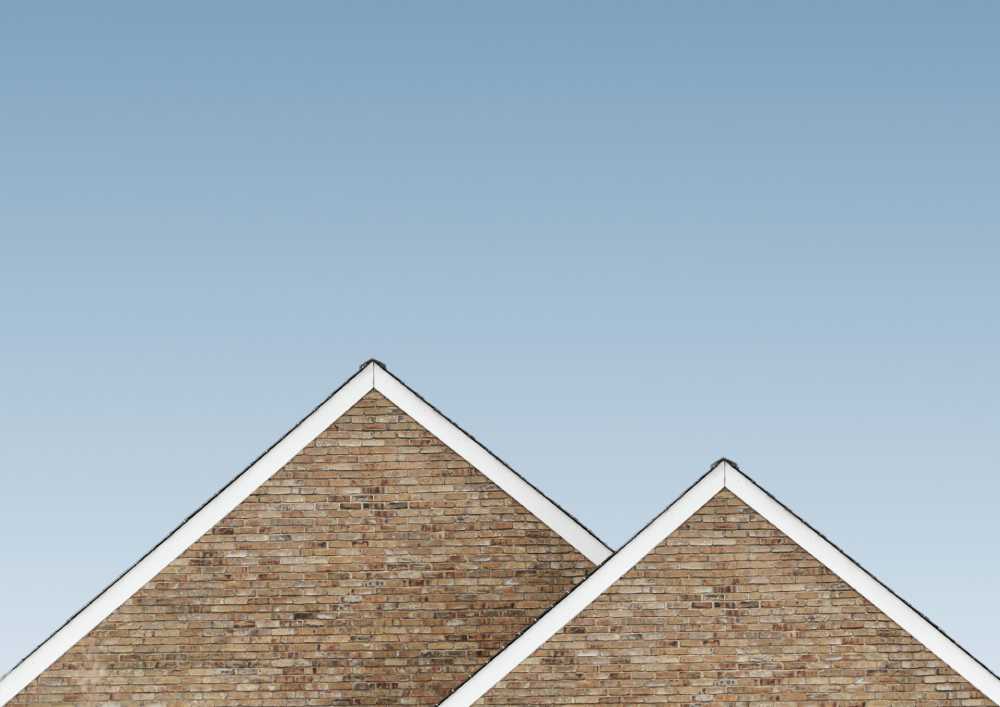Experts say the best-looking and most functional roof designs follow the “Golden Ratio.” The graph represents one side of the roof of a building. the slope of the line is. These designs typically have slopes between 4:12 and 10:12. A roof slope of 5:12 (about 22.62 degrees) creates the perfect balance of visual appeal and functionality.
Most homeowners see roof slope ratio as just another design choice. The slope is a vital part of preventing water damage and managing snow loads. The right roof slope stops water from pooling that could damage the structure and lead to costly repairs. Your roof’s slope measurement (the ratio of vertical rise to horizontal run) affects everything from material choices to maintenance needs.
This piece breaks down the quickest way to calculate slopes and shows you how to measure them easily. Understanding these measurements helps you make smart choices about your home’s protective covering. This knowledge becomes valuable when you plan renovations or pick roofing materials.
Roof Slope Basics for Homeowners
Your roof’s slope measurement system works in a simple way. The slope shows how many inches your roof rises vertically for every 12 inches of horizontal extension. A roof with a 6/12 pitch rises six inches for every foot it extends horizontally.
What exactly is roof slope and why it matters
Roof slopes typically fall into these ranges:
- Flat/Low Slope: 2/12 to 4/12
- Conventional Slope: 4/12 to 9/12
- High Slope: 9/12 and above
Your roof’s slope plays a crucial role in water and snow management. Steeper pitches let water run off quickly, which reduces leak risks and water damage. Homes in heavy snowfall areas benefit from higher pitches that prevent dangerous snow buildup on the roof.
Common roof slope terminology simplified
Roofing experts use specific terms to discuss roof slopes. A roof pitch ratio like 4/12 shows the vertical rise in the first number, while the second number (always 12) represents the horizontal run. This standard system helps homeowners and contractors communicate clearly about roofing work.
How roof slope affects your home’s value
Roof pitch affects your home’s value in several ways. Steeper roofs need more materials and special installation methods that increase replacement costs. A roof with a 9/12 pitch might cost $830,000+ to replace, while a low-slope roof costs around $700,000+.
Roof pitch also determines which materials work best for installation. Some shingles and tiles perform better with specific slopes, which affects both upfront costs and maintenance needs. The right pitch choice leads to better material compatibility and a longer-lasting roof system.
How to Calculate Roof Slope: The Simple Method
Measuring your roof’s slope might seem scary at first, but homeowners can get accurate and safe measurements with the right tools and the quickest way.

Simple tools you’ll need for measurement
You need to gather the proper tools before climbing up to measure. Here’s what you’ll need:
- A 12-inch level (or longer)
- Measuring tape
- Pencil and paper
- Calculator (optional)
- Safety equipment (ladder, harness, non-slip boots)
Step-by-step measurement guide
Your roof slope calculation becomes easy when you follow these precise steps:
- Place the level horizontally against the roof surface or rafter
- Mark exactly 12 inches on the level
- Measure the vertical distance from the roof to the level at the 12-inch mark
- Record this measurement as the rise
You can take these measurements from three different locations:
- The roof surface
- Inside an unfinished attic
- At the rake board area
The attic often gives you the most accurate results, especially when you have uneven surfaces from roofing materials.
Common mistakes to avoid
Most people make three critical errors when calculating roof slope:
- Inaccurate Level Placement: Your level must stay perfectly horizontal to get accurate measurements
- Forgetting Roof Overhangs: Take measurements from the main roof section, not the overhang
- Misunderstanding Pitch Ratios: The horizontal run stays at 12 inches, whatever the rise
Safety comes first. The attic provides an equally effective and much safer option if you’re unsure about roof surface measurements. Modern technology offers another solution through smartphone apps that measure roof slope accurately without requiring roof access.
Visual Guide to Finding the Slope of Your Roof
Modern technology makes finding roof slope easier than ever. Digital tools are now accessible to more people right from their phones. Homeowners can get precise measurements without climbing onto their roofs.
Using smartphone apps for measurement
Several reliable apps are now great tools to calculate roof slope:
- Pitch Gage 3.0: Creates detailed 3D models of roofs and makes precise pitch measurements possible through smartphone cameras
- VELUX Roof Pitch: Measures roofs directly when you place your phone or use camera mode
- Roof Pitch Factor: Shows both pitch factor and degrees through camera view, which works well for beginners
These apps have revolutionized how professionals and homeowners measure their roofs. The Pitch Gage app has features like cloud storage and detailed reporting options.
Reading roof slope diagrams
Roof pitch charts are a great way to get insights into various roof slopes. The roof pitch chart shows common pitch ratios that help match your priorities with practical needs.
A roof slope diagram’s simple components are:
- Rise (vertical measurement)
- Run (horizontal measurement)
- Ratio expression (such as 4:12)
Pitched roofs fall into three main categories:
- Low-pitch: 0 to 3 degrees
- Medium-pitch: 4 to 8 degrees
- Steep-pitch: 9 to 12 degrees
Photo examples of different roof slopes
Visual identification helps you understand different roof slopes better than digital measurements alone. Common roof styles and their features include:
- Flat Roofs: Perfect for solar panels and rooftop gardens
- Gable Roofs: Provide excellent water drainage and ample attic space
- Hip Roofs: Offer superior wind resistance, which works well in severe weather areas
Different slopes serve different purposes. A walkable roof typically needs a pitch of 7/12 or below. Steeper pitches work better at shedding snow and water.
Practical Applications of Roof Slope Calculations
Calculating roof slope gives homeowners the ability to make smart decisions about their property investments. The way you understand roof calculations will affect your renovation budget, material choices, and long-term maintenance plans.
Estimating renovation costs
Roof slope affects renovation expenses by a lot through multiple factors. A roof with a simple 3/12 pitch might cost around $7,000 for a 40-by-50-foot area. Notwithstanding that, costs rise as the pitch increases:
- 6/12 pitch: Adds approximately $1,000 to base cost
- 9/12 pitch: Increases to $8,300+
- 12/12 pitch: May exceed $10,000
Steeper roofs need extra safety equipment and specialized labor, which drives up the overall project costs.
Choosing the right roofing materials
Your roof’s pitch determines which materials will work best. Here’s a detailed breakdown of material compatibility:
Low-slope roofs (0.25/12 to 3/12):
- Built-up roofing (BUR)
- Rubber membrane (EPDM)
- Torch-down roofing
Medium to steep-slope roofs (4/12 to 20/12):
- Asphalt shingles
- Clay or cement tiles
- Metal roofing
Asphalt shingles remain popular, but they shouldn’t go on roofs with pitches lower than 2/12. These materials can cause water damage and wear out too soon when installed on improper slopes.
Planning for maintenance and repairs
Roof pitch determines maintenance needs. Steeper roofs get rid of water and snow quickly, which prevents structural issues. A good maintenance schedule should include:
- Drainage Inspection: Low-slope roofs need more checks for water pooling
- Material Monitoring: Different slopes wear materials at different rates
- Safety Preparations: Steep pitches need professional maintenance because they’re hard to access
Regular checks become vital especially when you have heavy rainfall. Note that low-pitched roofs need more frequent maintenance because water can collect and cause leaks more easily.
Safety Tips When Measuring Roof Slope
Safety should be your top priority when you just need to calculate roof slope. The right preparation and awareness of potential risks can prevent serious accidents during measurements.

Essential safety equipment
The right safety gear is vital for anyone who plans to measure roof slope. Here’s what you just need for safe roof access:
- Fall protection harness and secure anchor points
- Non-slip boots with excellent grip
- Sturdy ladder with rubber feet
- Hard hat and safety gloves
- Safety rope or lifeline system
Your safety equipment must be CSA-approved and checked before each use. You should make sure every piece meets current safety standards instead of risking injury with inadequate protection.
When to call a professional
Many homeowners love DIY projects, but some situations just need professional expertise. You should contact a qualified roofer in these cases:
- Roofs with slopes steeper than 4:12 pitch
- Heights exceeding 3 meters (10 feet)
- Complex measurement requirements
- Unsafe roof conditions
- Lack of proper safety equipment
Professional roofers go through specific safety training and certification. They have the expertise and equipment to handle challenging measurement tasks safely and accurately.
Weather considerations
Weather conditions play a big role in roof measurement safety. Many homeowners miss this significant factor while planning their measurement activities.
These weather-related hazards can make roof access dangerous:
- Moisture Issues: Rain creates slippery surfaces and increases fall risks
- Wind Concerns: Strong winds can affect balance and make equipment handling difficult
- Temperature Impact: Extreme heat can affect adhesives and materials
- Visibility Problems: Poor lighting or fog can impair accurate measurements
- Material Conditions: Snow, ice, or accumulated debris make surfaces treacherous
You should keep an eye on current and forecasted weather conditions. The best time to measure your roof is during dry, calm weather with moderate temperatures.
If you’re worried about immediate roof issues like leaks during rainstorms, it’s safer to place a bucket under the problem area temporarily than to attempt measurements in dangerous conditions. Professional roofers have the training and equipment to handle emergencies safely, making them your best choice for urgent measurement needs.
The Graph Represents One Side Of The Roof Of A Building. The Slope Of The Line Is Frequently Asked Questions
What does the slope of the line on this graph represent?
The slope of the line on this graph represents the rate of change between the two variables being compared. In many real-world applications, such as construction, the graph represents one side of the roof of a building, where the slope helps determine the steepness of the roof. Understanding this rate of change is crucial in fields like engineering and physics.
What is the slope of the line?
The slope of the line is the measure of its steepness, calculated as the ratio of vertical change (rise) to horizontal change (run). If the graph represents one side of the roof of a building, then the slope of the line is an essential value for ensuring proper drainage and stability. The slope can be determined using a simple formula, often represented as m = rise/run.
What is the slope of the graph rises from left to right?
If the slope of the graph rises from left to right, it means the slope is positive. A positive slope indicates an increasing relationship between the variables, such as height increasing with distance. This is often observed when measuring inclines, like how to find slope of roof in construction.
Which word describes the slope of the line representing the data in the table?
The word that best describes the slope of the line depends on its direction and steepness. If the line is going up from left to right, it is positive; if it goes down, it is negative. If the slope remains constant, it can be described as linear or steady.
What does the slope of the graph represent?
The slope of the graph represents the rate at which one variable changes in relation to another. For example, in roofing, the slope can indicate how to calculate roof slope to ensure proper water drainage. It is useful in various fields, from physics to economics, to analyze trends.
What is a slope in a graph?
A slope in a graph is a numerical value that describes the steepness and direction of a line. It is calculated by finding the ratio of vertical change to horizontal change. In construction, knowing how to calculate the slope of a roof is critical for designing safe and efficient buildings.
How to identify a slope?
To identify a slope, observe the change in y-values compared to the change in x-values between two points. The slope is positive if the line moves upward from left to right and negative if it moves downward. You can also determine it algebraically using the formula m = (y₂ – y₁) / (x₂ – x₁).
What is the slope of a line quizlet?
On Quizlet, the slope of a line is often defined as the ratio of the vertical rise to the horizontal run. It helps describe the relationship between variables in an equation and is essential for solving linear equations. Many students use Quizlet to study concepts such as how to calculate slope of roof.
How to find slope without points?
To find slope without specific points, you can use alternative methods like estimating from a graph, using an equation in y = mx + b form, or measuring a physical structure like a roof. In construction, knowing how to calculate the slope of a roof without precise coordinates can be done using a level and measuring tape.
Which word best describes the slope of the line?
The best word to describe the slope of the line depends on its characteristics. A positive slope rises, a negative slope falls, a zero slope is flat, and an undefined slope is vertical. In practical applications, how to find slope of roof involves identifying these variations.
What is a straight line on a graph called?
A straight line on a graph is called a linear graph. This type of graph represents a constant rate of change between two variables. For example, in architecture, the slope of a roof can be represented as a straight-line graph.
What is the standard form in math?
The standard form in math for a linear equation is Ax + By = C, where A, B, and C are constants. This form is useful for solving equations and graphing lines, especially when working with real-world scenarios like calculating angles in roofing.
How do you classify slope?
Slope is classified into four types: positive, negative, zero, and undefined. A positive slope moves upward, a negative slope moves downward, a zero slope is horizontal, and an undefined slope is vertical. Understanding how to calculate roof slope helps classify slopes in construction projects.
What does point slope look like?
Point-slope form looks like y – y₁ = m(x – x₁), where m is the slope and (x₁, y₁) is a known point on the line. This form is useful for finding equations of lines when given one point and the slope. It can also help determine slopes in structures like roofs.
How to find the y-intercept?
To find the y-intercept, set x = 0 in the equation of the line and solve for y. In the equation y = mx + b, the b value is the y-intercept. For graphs representing buildings, the y-intercept might indicate the starting height of a structure.
How to solve a linear equation?
To solve a linear equation, isolate the variable by using inverse operations like addition, subtraction, multiplication, or division. For example, if given 3x + 6 = 12, subtract 6 from both sides and divide by 3 to find x = 2. In real-world applications, solving for x can help determine angles and lengths when designing slopes.
